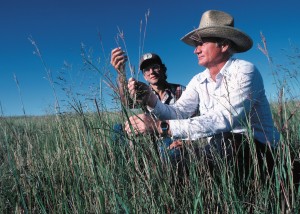We have much more to do and your continued support is needed now more than ever.
Guidelines to Produce Energy Grasses in Wildlife-Friendly Ways
One of the great things about my job is being able to learn more about wildlife from experts at the National Wildlife Federation, in other organizations, and with consultants working on projects for us. One such project has been especially near and dear to me, since it touches on my love for grasslands as well as my interest in bioenergy.

The BMGs were written by consulting wildlife experts Bill McGuire and Susan Rupp. An interdisciplinary team of wildlife experts worked with Bill and Susan, and external reviewers with practical expertise provided valuable feedback.
Focus on the Prairie Pothole Region but relevant elsewhere

The BMGs are relevant to many areas of the country, but they have a regional focus on the Prairie Pothole Region (PPR), which is located in the Dakotas and parts of IA, MN, NE, WY and MT. The region stands at the cross-roads of wildlife and bioenergy because its matrix of shallow wetlands, grasslands, and croplands provides nesting habitat to over half the ducks in the country, and the Upper Midwest’s soils and climate have some of the highest feedstock production potential in the US.
Getting grass-based biomass right in the PPR is also critical because in the last five years, the region’s seen over a million acres of planted and native grasslands converted to cropland, largely due to increased demand for corn to make ethanol. We need the fewer grasslands we have left to do a lot for wildlife—and other ecosystem services, like clean water and carbon sequestration.
Before I started working on the project, I assumed that planting perennial grasses on farmland would be such a clear improvement for wildlife over annual crops like corn soy, which need planting, fertilizing and other inputs every year, that it would be an important victory in its own right. After all, most crops like soy or corn, though they do provide food to some species, offer limited nesting habitat and even less cover after harvest, and the downstream pollution from annual crops, especially corn, are well-known. The advantages of perennials in a sea of annual crops are all true and important—as far as they go.

Highlights of the guidelines
Some highlights of the BMGs are to:
- Use native grasses. A mix of indiangrass, big bluestem and sideoats grama is recommended to benefit more species, but the BMGs also include recommendations for switchgrass-only stands that industry might prefer.
- Plant bioenergy crops on existing cropland rather than converting native sod or wetlands.
- Plant bioenergy crops next to potholes, native prairies, or other planted grasses to create larger tracts that provide habitat to species that avoid the edges of habitat.
Beyond these and other major recommendations, the BMGs include suggestions related to more subtle interactions, such planting density, how much fertilizer and pesticide to use, the timing of harvest, using a flushing bar on the harvester to reduce bird injuries, and leaving taller stubble along field borders for winter cover and water quality benefits.
Importantly, the guidelines are not intended to be one-size-fits-all; they were written with the understanding that they will be need to be adapted for specific circumstances and operations.
Applying the guidelines
I look forward to working with bioenergy companies on implementing the BMGs, including one company we are talking with already that’s planning on growing tens of thousands of acres of native grasses as an energy feedstock in a few years—and wants to do right by wildlife. I hope to be able to share the details of this collaboration shortly.





















